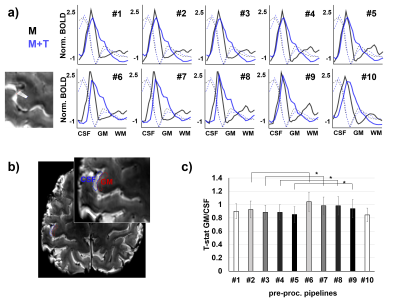Patricia Pais-Roldan1, Seong Dae Yun1, and Jon N Shah1
1Forschungszentrum Juelich, Juelich, Germany
1Forschungszentrum Juelich, Juelich, Germany
Sophisticated
pre-processing with added voxel-wise regression of the phase signal
from the pre-processed magnitude increases the accuracy of GE
signals, allowing whole-brain, high-resolution GE-sequences to be
exploited in the resting-state laminar fMRI field.

Figure
2.
Signal
amplitude and independence in resting-state data.
a)
The image shows the location of nine voxels crossing the cortical
ribbon (“cross-cortex line”) that were used in the successive
analysis. b)
Power of low-frequency fluctuations at different points of the
cross-cortex line calculated for ten different pre-processing
pipelines. c)
Mean homogeneity, assessed as correlation and coherence between pairs
of voxels in the cross-cortex-line. Error bars represent standard
error of the mean. Different letters indicate significantly different
groups.

Figure
3.
Identification
of evoked responses. a)
Line activation profiles, calculated as the mean beta-value across 20
lines (see inset on the bottom left), for two task-fMRI scans
involving either motor-only (M) or motor and sensory processing
induced by touch (M+T), computed after pre-processing with ten
different pipelines. The dashed lines indicate the intensity of the
mean functional image. b)
ROIs selected for group analysis. c)
The GM to CSF ratio of the t-statistic. Asterisks indicate
significant differences between pre-processing pipelines (p<0.05).
